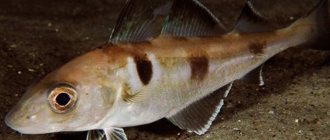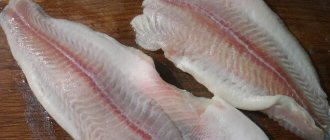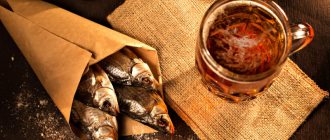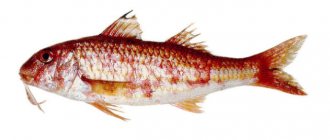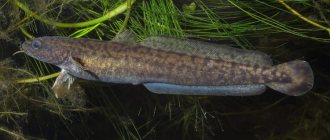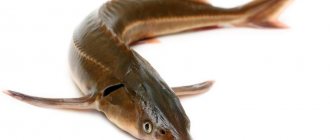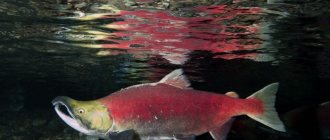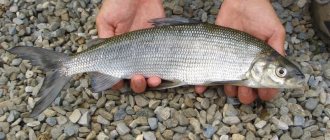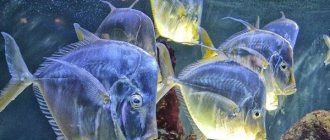She has an interesting body shape, which contributes to her life at the very bottom. The meat of any type of flounder has specific characteristics. Despite this, humanity has always used the meat of this fish for various purposes, including culinary purposes.
What it looks like and where it lives
Flounder is difficult to confuse with other fish. You will immediately find it on the store counter: it has a flat body with a characteristic oval shape, and its eyes are located on one side of the body. The sides have different colors - one is light and the other is dark with an olive tint.
The average size of the fish is 50 cm - an individual usually reaches it in five years of life. By the way, flounder can be called one of the longest-livers in the sea, because it lives on average 30 years.
There are few bones in it, they go mainly around the head and from the spine and are very easily separated. There are very small bones in the fin area. So flounder will certainly appeal to those who don’t like bony fish.
Flounder is predominantly a marine inhabitant and is most common in the Atlantic Ocean, White, Okhotsk and Baltic Seas. However, there is also a river variety of it - glossa.
The flounder family has up to five thousand species. The most famous of them:
- yellowfin or yellow-bellied;
- white-bellied;
- royal;
- halibut-shaped;
- star-shaped;
- dab;
- Murmansk flounder-ruff.
Interesting fact: many people do not know the difference between halibut and flounder. The answer is simple: they belong to the same family, but halibut is larger and its meat has more fat content.
Interesting facts about flounder
The bizarre fish makes an interesting exhibit for research. These unusual facts will definitely convince you of the uniqueness of flounder:
- The eyes are shifted to one side.
- The fish changes color in the area of the body where the visual organs are located in order to camouflage itself with the surrounding area.
- There are blind species of flounder; they are not able to mimic.
- The pulp contains a powerful aphrodisiac - a substance that enhances sexual potential.
- It is the only fish discovered at a depth of about 11 kilometers when diving into the Mariana Trench.

Chemical composition and calorie content
Flounder is known not only for its unusual appearance. It is valued for its composition, rich in healing substances and microelements, such as:
- vitamin A, D, E, C;
- B vitamins;
- iodine;
- sodium;
- phosphorus;
- magnesium;
- copper.
100 grams of fish contain the most water (80 g) and proteins (15 g). There is very little fat - only 3 grams, and there are no carbohydrates at all.
Flounder has a low calorie content and, due to this, outperforms meat and poultry.
In its raw form, the calorie content per 100 grams of fish is about 80 kcal; for boiled fish, this figure increases to 100 kcal; for fried fish, up to 120 kcal.
The most calories are in the hot smoked product. Its energy value reaches 200 kcal.
Description of flounder and its nutritional value
The unusual fish can live in bodies of fresh and salt water. All marine and river individuals reproduce only in the ocean or sea, but despite this, some representatives of the species prefer to live in river waters.
Appearance and varieties
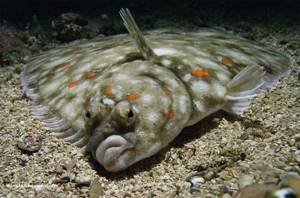
In the water column, the fish swims in a horizontal direction, making wave-like movements with its body. It feeds on mollusks, sea worms, and small fish. Flounder usually goes out hunting at night and, hiding in secluded places or burying itself in the sand at the bottom, waits for its prey. During the day, she rests in dense algae or behind large stones.
Marine inhabitants differ from freshwater ones in their larger sizes and can weigh from 8 to 15 kg, while river individuals reach only 2-2.5 kg. Females are usually larger than males, and adult fish can grow from 40 to 50 cm in length.
The most popular flounder species include the following:
- Atlantic long.
- Greenland halibut.
- White-bellied.
- Star-shaped.
- Yellow-bellied.
- Proboscis.
- Linear.
- Yellowfin.
- Polar.
River and sea specimens differ in weight, size, location of eyes and color of scales. But all varieties have a common feature - these fish are able to quickly change the shade of their body upon contact with surrounding objects at the bottom of the reservoir.
Chemical composition and calorie content
Flounder meat is an irreplaceable source of protein , it contains no carbohydrates and contains a very small percentage of fat. Therefore, its energy value is only 85 calories per 100 grams of product. Fish fillets contain polyunsaturated fatty acids Omega 3, water, ash and cholesterol.
The benefits of flounder for human health lie in the content of essential vitamins :
- A - 14.5 mcg.
- B 6—0.3 mg.
- E - 1 mg.
- B 12-1.3 mcg.
- C - 1.2 mg.
- B 9-7 mcg.
- PP - 5 mg.
- B 2-14 mcg.
- D - 3 mg.
Fish fillet is rich in minerals , which are necessary for the normal functioning of all organs in the human body:
- Magnesium - 32 mg.
- Potassium - 360 mg.
- Phosphorus - 183 mg.
- Selenium - 34 mcg.
- Copper - 112 mcg.
- Calcium - 43 mg.
- Iodine - 48 mcg.
- Sodium - 68 mcg.
- Zinc - 0.46 mg.
- Iron - 0.8 mg.
- Sulfur - 188 mg.
- Fluoride - 420 mg.
Valuable components have a beneficial effect on well-being, normalize heart function, strengthen the skeletal system and teeth, smooth out the skin structure and improve brain activity. Therefore, nutritionists recommend including flounder dishes in your diet more often. The fillet of this fish is also used in the cosmetics industry - collagen is produced from it, which is used in the manufacture of creams, masks, serums, and lotions.
Beneficial features
The main benefit of flounder for the human body is its high amino acid content:
- aspartic;
- glutamine;
- threonine;
- serine;
- glycine
These substances promote more active collagen production, act as antioxidants, slow down the aging process, and also help to better tolerate stress and increase brain activity.
Fish also contains omega fatty acids, which lower the amount of bad cholesterol in the blood. They improve the functioning of the heart muscle and blood vessels, and significantly reduce the risk of thrombosis.
Other beneficial characteristics of flounder contribute to:
- improving vision;
- normalization of the nervous system;
- reducing the risk of developing depression;
- increasing immunity.
Benefits for children
You can give this fish to a child starting from 8-9 months. The protein and amino acids it contains in abundance will help in the formation of muscle tissue and internal organs.
Flounder contains a lot of iodine, which ensures good functioning of the thyroid gland and improves the child’s metabolism. Large amounts of calcium, magnesium and phosphorus will help your baby have healthy teeth and bone tissue.
I recommend starting complementary feeding with boiled fish, crushed to a puree. Carefully monitor your baby's reaction, and if allergies or digestive problems occur, avoid this product for a while. Also try to clean the fish carefully so that no bones get into the puree.
Features of the effect on the body
Benefits for men and women
A beneficial effect of flounder on the production of sex hormones in men and an increase in potency has been noted. Protein saturation stimulates muscle growth during muscle formation, which is greatly appreciated by athletes.
For women, this product will be useful in creating diets for a slim figure and improving the condition of the skin, hair, and nails. Polyunsaturated fats are essential for maintaining women's health.
Is it harmful for pregnant and lactating women?
Iodine, which is abundant in flounder, contributes to the proper development of the fetus and the prevention of thyroid dysfunction, therefore it is recommended during pregnancy, the postpartum period and lactating women.
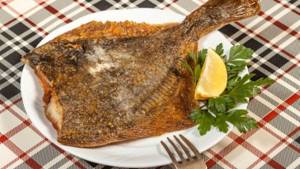
If you are not allergic to sea fish, it can be used for toxicosis. And polyunsaturated fats act as a prevention of gynecological diseases.
In the diet of children
Due to its high iron content, caviar is recommended to be given to children with anemia, and to adolescents during active growth. It is useful to use when there is a threat of developing thyroid diseases due to iodine deficiency. Caviar is usually fried or salted. Its composition is not inferior to fish fillet, its protein is also well digestible, it contains the same vitamins and minerals.
It is not recommended to feed children under one year old with flounder (especially marine varieties) so as not to disrupt the still developing endocrine system.
Use in old age
For older people, regular consumption of fish helps prevent cardiovascular diseases, atherosclerosis, and oncology. Regular consumption of food slows down the aging process , prevents the development of wrinkles and decreased skin tone.
Salted fish retains fluid in the body , causing swelling, which puts a strain on the kidneys. Dried flounder can be harmful to people with gastrointestinal diseases. The abundance of salt in it can cause arthritis in older people.
Benefits for the elderly
Flounder is highly recommended for mature people over 50 years of age. After all, the vitamin E it contains helps slow down the aging of the body, reduce the risk of memory problems and improves brain activity.
A favorable combination of beneficial substances helps in the treatment of joints and strengthens bone tissue, and also improves the functioning of the heart.
Interesting fact: don’t forget about flounder caviar. It contains even more useful substances than the fish itself, and a lot of iron. If desired, caviar can be salted or fried, although in this form it will be contraindicated for those who suffer from pancreatitis or liver and kidney diseases.
Benefits for pancreatitis
Flounder can also help those who suffer from inflammation of the pancreas. This disease requires a particularly strict diet, and fish will help make it more interesting without causing any harm to the body.
I recommend steaming the flounder whole or in the form of cutlets. This will save nutrients as much as possible. Remember that in this case you need to add spices very carefully, and it is better to limit yourself to a small amount of salt.
Important! If you have pancreatitis, you should not eat fish soup, as well as smoked and fried fish.
Harm to the body from flounder
First of all, beware of eating flounder in large quantities. Like any other fish such as cod, tuna, king mackerel and wild sturgeon; Flounder contains some mercury in its tissues, which can harm pregnant women and children if consumed in large quantities. According to the American Pregnancy Association, pregnant women and children should not consume more than 340 grams of flounder per week.
Tags: Flounder
- Related Posts
- Mercury in Tuna: Is This Fish Safe to Eat?
- Is grilled chicken healthy?
- How many calories are in chicken? Chicken breast, thigh, wings, drumstick
« Previous entry
Use in cooking
You can find interesting flounder dishes in the recipes of many countries.
It can be boiled, steamed, baked in the oven or fried in a frying pan. The fish can be stewed with vegetables or mushrooms, or fillet rolls can be made.
Flounder goes well with almost any side dish. Choose what suits you best: rice, potatoes or vegetables.
The delicate taste of fish is perfectly complemented by olives, pepper, bay leaves and lemon.
Many people are hesitant to try recipes with flounder because the process of processing it has its own characteristics and may seem complicated. Trust me, this is not true - read our material on how to clean flounder and you will see for yourself that it is very simple.
I prefer to bake it in the oven - it turns out quickly and very tasty.
Simply place the fish on pre-prepared foil, drizzle with a little olive oil, and season with salt and pepper. Also add potatoes, cut into small slices, and cherry tomatoes.
Wrap and place in an oven preheated to 180 degrees for 20-30 minutes. This way you will immediately prepare a complete dish with a side dish.
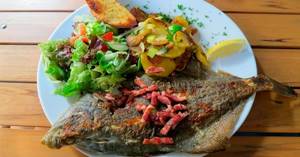
If you are watching your figure or trying to lose extra pounds, it is healthier to steam fish. Yes, its taste will be more delicate, but it will retain more vitamins and will not add calories. In this case, a salad of cucumbers and tomatoes is ideal as a side dish.
On our website you will find other delicious flounder recipes.
Is it possible for children
It is advisable to introduce flounder fillet into complementary foods from the age of one year. The children's menu should include 30-100 g of fish 3 times a week, depending on age. Up to 3 years, boiled pulp, broths, and steamed cutlets are recommended. For older children, baked fillet with vegetables is suitable.
Chemical elements and vitamins in fish meat:
- control the production of thyroid hormones;
- help strengthen the child’s skeleton at the stage of active growth;
- improve memory;
- have a beneficial effect on vision;
- fill the body with energy for the whole day.
Children and adolescents suffering from anemia should eat fish daily to increase hemoglobin.
Harm and contraindications
Flounder does not have many contraindications, but it should not be eaten by those who are allergic to seafood or have hyperthyroidism.
You should also refrain from eating smoked and dried fish if you suffer from liver and kidney diseases.
Excessive consumption of fried or smoked fish can negatively affect joints and cause swelling.
You need to be very careful when eating raw fish. If it has not been stored in accordance with all sanitary standards, it may contain eggs of parasites dangerous to humans - helminths.
You can learn more about the properties of fish from the video.
How to choose and store correctly
Flounder lives at the bottom of reservoirs, so over time it can accumulate harmful substances from the water and small fish on which it feeds. Therefore, it is so important to choose sellers who strictly monitor the quality of the products offered and their storage conditions.
It is best to buy medium-sized fish - about 30 cm. It will have the most delicious and tender meat.
In addition, pay attention to the following details:
- the smell is welcome, characteristic but pleasant;
- the color is not dull, and the gills are pink;
- the eyes are transparent, unclouded.
It is best to buy fresh fish immediately before cooking, as it can be stored in the refrigerator for no more than 2 days. If you want to keep your fish longer, freeze it.
Interesting fact: the largest flounder was caught in the 70s of the last century and is kept in Korea: its weight is 130 kilograms and its length is more than two meters.
Dietary recipe for cooking flounder:
Ingredients:
- headless flounder 1 piece weighing 1.3-1.5 kg
- butter 50 g
- several sprigs of dill
- a few sprigs of parsley
- lemon 1 piece
- ground black pepper to taste
- salt to taste
- vegetable oil 1 tbsp. spoon
How to cook:
- Preheat the oven to 220°C.
- Remove the butter from the refrigerator and leave at room temperature to soften. Wash the lemon with hot water to remove the unhealthy waxy coating from the citrus. Cut in half.
- Wash the fish and dry using paper towels. Place it on a cutting board with the yellowish skin facing up. Using a sharp knife, make several shallow diagonal cuts.
- Remove its fins and rub it all over with salt. Place the prepared fish on a baking sheet greased with vegetable oil, with the yellowish skin facing up.
- Bake the fish for 5 minutes. Then remove the pan from the oven and sprinkle with the juice of half a lemon.
- Continue cooking for another 20 minutes on the top rack of the oven.
- Meanwhile, wash, dry and finely chop the dill and parsley. Measure out 2 teaspoons of each type of green.
- Place the chopped greens in a small bowl, add butter, pepper to taste and mash well with a fork into a homogeneous mass.
- Remove the fish from the oven and assess its readiness: the flesh should flake easily.
Transfer the baked flounder to a large platter and immediately top it with the herbed butter. Garnish with lemon slices and serve immediately.
